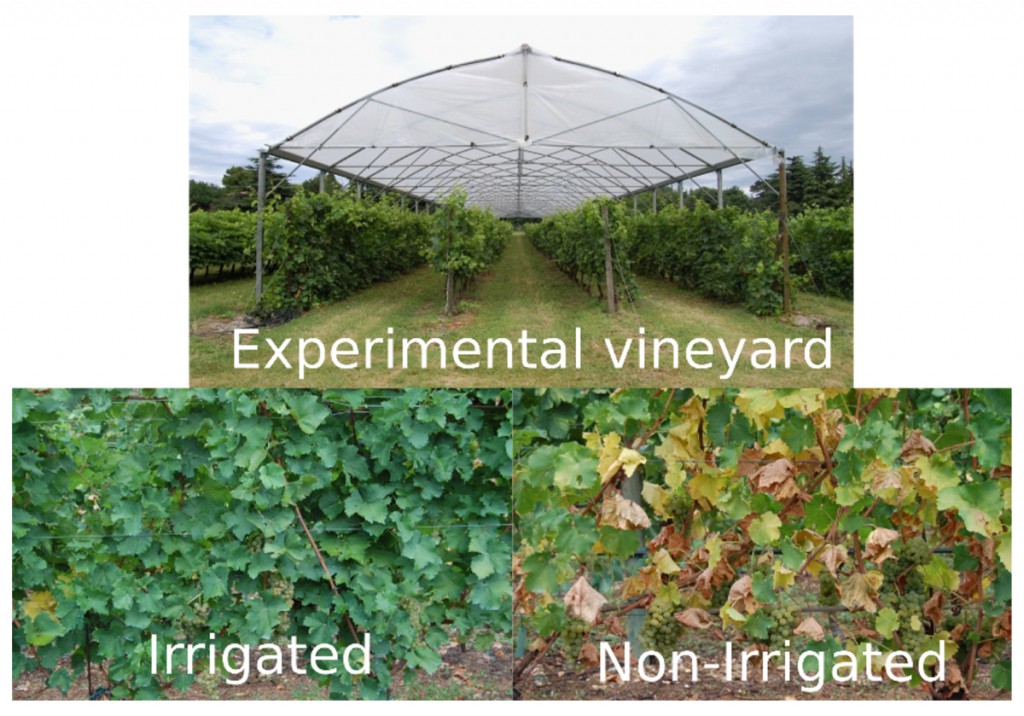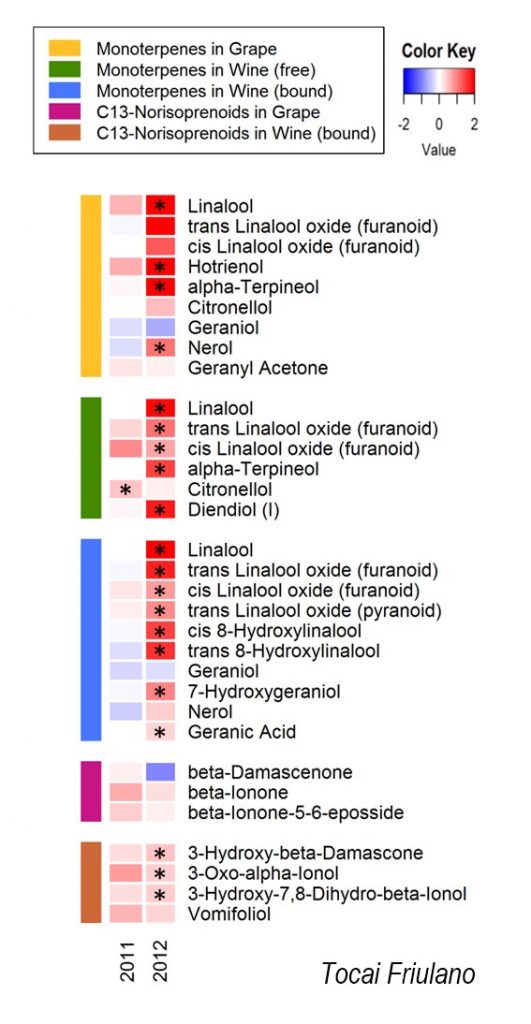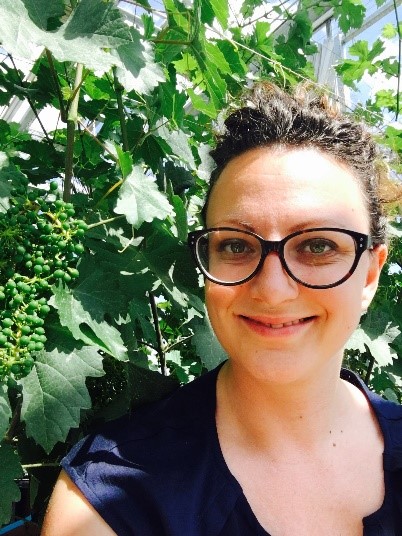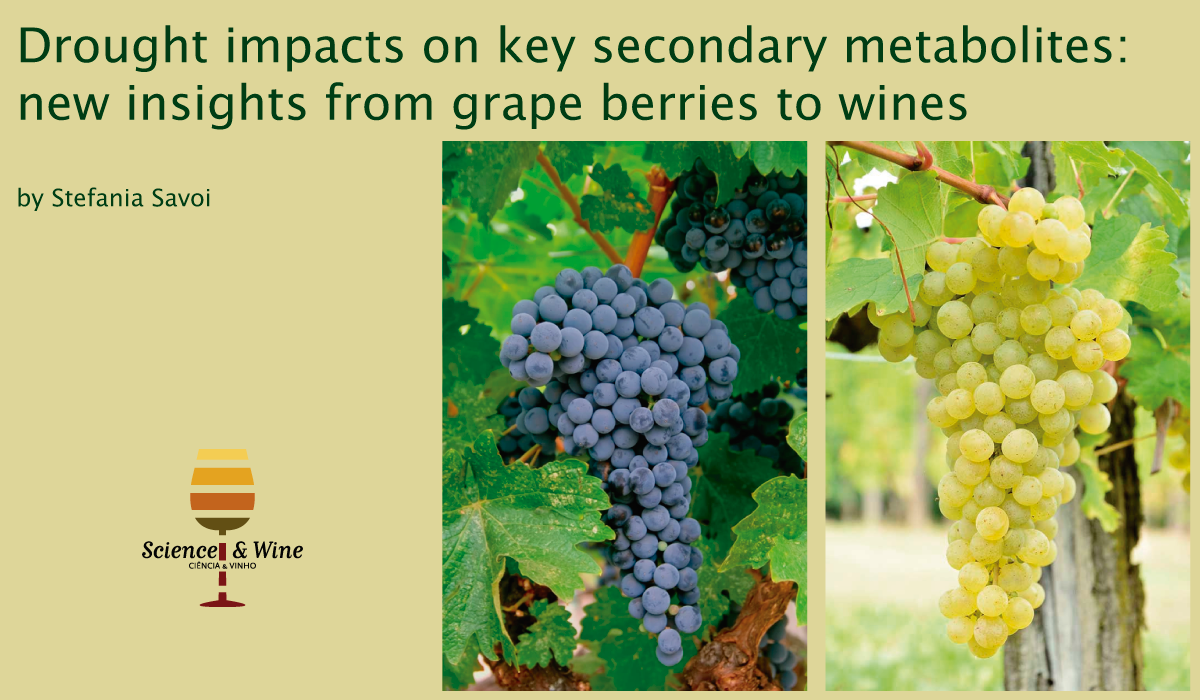by Stefania Savoi
Plants are sessile organisms and often they have to cope with environmental stresses such as drought, cold, heat, extreme light, excessive soil salinity, or several combinations of them. The genotype x environment (GxE) interaction is the source of the main variability in the responses to these constrains. Among the abiotic factors that can influence plant physiology, drought is the most relevant because it can influence plant growth and yield, and affects fruits composition. Secondary metabolism contributes to the adaptation of a plant to its environment. In fruit crops such as grapevine (Vitis vinifera), secondary metabolism also largely determines fruit quality. Grapevine is considered a drought-tolerant plant and traditionally is not irrigated, especially in Europe. Mediterranean climate, with warm and dry summers and cold and wet winters, is considered optimal for viticulture.
A multidisciplinary approach was adopted that considered a two-years field trial, high-throughput transcripts profiling (RNA-Seq) and large-scale targeted metabolite analyses to investigate the effect of drought events on the berry metabolism during fruit development and ripening in white and red grape varieties. An open field experiment was therefore conducted on Merlot (red grape variety) and Tocai Friulano (white grape variety) vines in 2011 and 2012, in a North Italian viticultural area characterized by transient drought events during the summer. Two irrigation treatments were applied to the vines: (i) fully-irrigated control vines (C) were weekly irrigated, in order to keep their stem water potential (a sensitive indicator of grapevine water status) between -0.4 and -0.6 MPa; (ii) deficit irrigated vines (D) were not irrigated from fruit set to harvest except in case of acute water deficit. Merlot vines were sheltered with an open-sided transparent cover at the beginning of the seasons, while Tocai Friulano vines were cultivated without any cover and hence subjected to the natural precipitations.

In Merlot, deficit irrigated vines experienced water deficit from 40-50 days after anthesis in both seasons. In Tocai Friulano, deficit irrigated vines manifested a late deficit (from 80-90 days after anthesis) in 2011, and a prolonged water deficit from early stages of fruit development (from 30-40 days after anthesis) to harvest in 2012.
For both varieties, berries were sampled for transcript and metabolite analyses during berry development and ripening. Furthermore, at harvest, grapes were microvinificated and wines composition was evaluated focusing on the secondary metabolites that largely contribute to the final color, taste, and aromatic features.

In Merlot berries, the drought stress response encompassed both ABA-dependent and ABA-independent signal transduction pathways with several VviAREB/ABFs, VvibZIP, and VviAP2/ERF-DREB transcription factors that were up-regulated by water deficit at one or more developmental stages. These transcription factors can play critical roles in the drought response by modulating a large suite of genes. Analyses of the central and specialized berry metabolism was conducted both at the transcript and metabolite levels by investigating several metabolic pathways. The study revealed that water deficit enhanced the accumulation of several osmoprotectants (proline, sucrose, and raffinose) and of secondary metabolites such as anthocyanins and C5, C7, C8, and C9 volatile organic compounds. The wines produced from grapes subjected to water deficit revealed a higher concentration of anthocyanins that determined higher color intensity and a bluer coloration of the wines.

A large effect of water deficit on fruit secondary metabolism of the white grape variety Tocai Friulano was observed in the 2012 season when the deficit occurred from early stages of berry development to harvest. In that season, increased concentrations of phenylpropanoids, monoterpenes, and tocopherols were observed, while carotenoid and flavonoid accumulations were differentially modulated by water deficit accordingly to the berry developmental stage. In parallel, RNA-Seq analysis revealed that many key genes of the phenylpropanoid, flavonoid, and terpenoid pathways were modulated by water deficit indicating a transcriptional regulation of these specific pathways in the berry under drought. The higher co-regulation of several terpenoid transcripts with monoterpene accumulation under water deficit and the enrichment of drought-responsive elements in the promoter region of many terpenoid genes highlight that drought can enhance the production of these flavour components in grapes with potential effects on wine composition and sensory features. The wines produced from grapes subjected to water deficit revealed a more pronounced accumulation of monoterpenes and C13-norisoprenoids, and especially glycosidically-bound compounds. However, differences in the metabolic response between seasons suggest that the endurance of water deficit and the timing of application strongly impact this response.

A comparison between the two varieties can be done only for the 2012 season, when levels and endurances of water deficit were similar between Tocai Friulano and Merlot deficit irrigated vines. The data indicate that water deficit modulated the accumulation of several secondary compounds; however, the modulation of the secondary metabolism varied between cultivars indicating a genotype x environment interaction. In the Tocai Friulano berry, water deficit stimulated the synthesis of phenolic acids, tocopherols, and monoterpenes, such as linalool, α-terpineol, nerol, and hotrienol. In Merlot, the response especially included an overproduction of anthocyanins, such as the tri-substituted delphinidin, petunidin, and malvidin both in the glycosylated and acylated form.
These results indicate that drought events can affect the composition and sensory features of red and white wines by increasing the accumulation of pigments in the red grape variety and monoterpenes in the white grape variety.
These researches were carried out thanks to:


Stefania Savoi is an Italian researcher working on grapevine physiology (development and abiotic stresses) using primarily transcriptomic and metabolomic approaches.
She was born on a little valley, called Valle di Cembra, dedicated to the “heroic viticulture” where the local grow mainly Müller Thurgau, a grape white variety, surrounded by the gorgeous Italian Dolomites. After her biotechnological studies at the University of Verona (Italy), she did a PhD implementing the research described above at the Fondazione Mach (Italy), the University of Udine (Italy) and she spent 8 months at the UBC in Vancouver (Canada). In 2016 she started her first postdoc working on a grape ripening disorders near Vienna (Austria), and currently, she is completing her second postdoc at the Montpellier SupAgro (France) studying grape berry ripening on a single berry basis. She is looking forward of new opportunities around the world.
For more information : savoi.stefania@gmail.com
References
- Savoi S, Wong DCJ, Arapitsas P, Miculan M, Bucchetti B, Peterlunger E, Fait A, Mattivi F, Castellarin SD (2016) Transcriptome and metabolite profiling reveals that prolonged drought modulates the phenylpropanoid and terpenoid pathway in white grapes (Vitis vinifera L.). BMC Plant Biol 16: 67
- Savoi S, Wong DCJ, Degu A, Herrera JC, Bucchetti B, Peterlunger E, Fait A, Mattivi F, Castellarin SD (2017) Multi-Omics and integrated network analyses reveal new insights into the systems relationships between metabolites, structural genes, and transcriptional regulators in developing grape berries (Vitis vinifera L.) exposed to water deficit. Front Plant Sci. 8:1124
- Savoi S, Herrera JC, Carlin S, Lotti C, Bucchetti B, Peterlunger E, Castellarin SD, Mattivi F (2020) From grape berries to wines: drought impacts on key secondary metabolites. OENO One 54: 569–582

